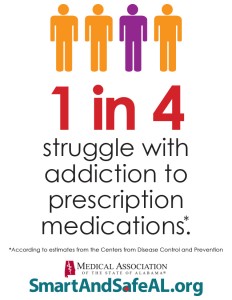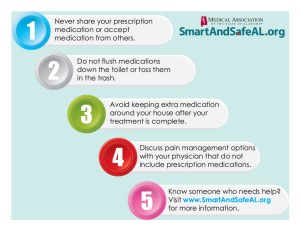Physicians
Reversing the Opioid Epidemic in Alabama: A Health Care Professional’s Toolbox to Reverse the Opioid Epidemic (REVISED)
CDC Guideline for Prescribing Opioids for Chronic Pain
A County Comparison: Annual Prescriptions Per Capita 2015
Alabama’s Prescription Drug Monitoring Program
The Medical Association’s Course on Prescribing of Controlled Drugs (ARE YOU REGISTERED?)
Alabama Board of Medical Examiners & Medical Licensure Commission of Alabama (NEW RULE)
Webinars from the American Medical Association
Continuing Medical Education from American Academy of Family Physicians
Reversing the Opioid Epidemic in Alabama: A Health Care Professional’s Toolbox to Reverse the Opioid Epidemic
The Medical Association partnered with the American Medical Association to create this new clinical tool in the fight against prescription drug abuse. Download the toolbox. (REVISED)
Download the Morphine Milligram Equivalent Reference Guide (REVISED)
CDC Guideline for Prescribing Opioids for Chronic Pain
This guideline was released on March 15, 2016, and provides recommendations for primary care clinicians who are prescribing opioids for chronic pain outside of active cancer treatment, palliative care, and end-of-life care. The guideline addresses 1) when to initiate or continue opioids for chronic pain; 2) opioid selection, dosage, duration, follow-up, and discontinuation; and 3) assessing risk and addressing harms of opioid use. It is important that patients receive appropriate pain treatment with careful consideration of the benefits and risks of treatment options. This guideline is intended to improve communication between clinicians and patients about the risks and benefits of opioid therapy for chronic pain, improve the safety and effectiveness of pain treatment, and reduce the risks associated with long-term opioid therapy, including opioid use disorder, overdose, and death. Read the guideline online or download the document.
A County Comparison: Annual Prescriptions Per Capita 2015
Curious where your county stands in the breakdown per capita of prescription opioids? Click here.
Alabama’s Prescription Drug Monitoring Program 
Alabama’s Prescription Drug Monitoring Program (PDMP) is a program developed to promote the public health and welfare by detecting diversion, abuse and misuse of prescription medications classified as controlled substances under the Alabama Uniform Controlled Substances Act. The PDMP database is maintained by the Alabama Department of Public Health, and any physician who dispenses Class II, III, IV and/or V controlled substances are required by law to report the dispensing of these drugs to the database.
The Medical Association’s Course on Prescribing of Controlled Drugs (ARE YOU REGISTERED?)
This intensive course is designed for physicians in all specialties, physician assistants, and certified registered nurse practitioners and nurse midwives to enhance the health care professional’s ability to effectively prescribe controlled medications while maintaining patient access to pain medications and minimizing misuse and abuse.
This course features some of Alabama’s most well-versed physicians in pain management and prescribing of controlled medications. Participants will have the opportunity to ask questions during this live continuing education event.
2018 Prescribing and Pharmacology of Controlled Drugs:
Prescribing Issues Related to America’s Opioid Crisis
Nov. 17-18
Hyatt Regency Birmingham/The Wynfrey Hotel
1000 Riverchase Galleria | Birmingham
For more information or to register, visit the Medical Association’s Prescribing website.
Alabama Board of Medical Examiners & Medical Licensure Commission of Alabama (NEW RULE)
Registration for Pain Management Services
Questions and answers about pain management services, registration with the Alabama Board of Medical Examiners, exemptions and the latest rules and regulations.
Click here for the Risk and Abuse Mitigation Strategies by Prescribing Physicians
Webinars from the American Medical Association
Difficult Conversations in Opioid Management: Limiting, Reducing, or Stopping Opioids
For many patients who are currently receiving long-term opioid therapy, potential harms of continued opioids may outweigh apparent benefits. This webinar focuses on how to communicate a patient-centered approach to limiting, reducing, or stopping opioids in a variety of clinical scenarios.
Trends in State Prescription Drug Laws: A Changing Health Care Environment
The presentation will outline latest legislative trends in state prescription drug monitoring programs, regulation of pain clinics and pain management, and prescribing practices for chronic pain. The presentation will also highlight some of the current challenges in effecting balanced improvements in these legislative trends.
A Brief Guide to Pharmacogenetics and Pain Management
This webinar will examine the genetic basis for differences in clinical responses observed among patients receiving opioid analgesics. Mutations in genes encoding the mu opioid receptor have been linked to the variability in responses to opioids. Other genetic polymorphisms affect the bioavailability and metabolic disposition of opioids and their metabolites. Pharmacogenetic studies also have provided a molecular foundation supporting opioid rotation in cases where efficacy diminishes or intolerable side effects occur. As genetic findings on specific opioid analgesics are extended, clinicians will be better positioned to identify from the outset which opioid analgesic may be most appropriate for an individual patient.
Multidimensional Care of Chronic Pain: Reducing Reliance on Opioids for Relief
This webinar will explore a multidimensional clinical approach to the treatment of chronic pain (and co-occurring mental health and substance disorders) that can be implemented in both primary and specialty practices. Readily available evidence-based options for active patient engagement in chronic pain treatment will be explored and tips on identifying clinical and support resources in community-based settings will be offered. The appropriate role of opioid analgesics in the context of active pain recovery also will be reviewed.
Continuing Medical Education from American Academy of Family Physicians
Appropriate and Effective Pain Management – Overcoming the Barriers
For AAFP members only
In one hour, you will learn strategies on how to overcome the most common barriers of chronic pain treatment. You will find practice solutions and earn 1 AAFP Prescribed credit.
ER/LA Opioid REMS: Achieving Safe Use While Improving Patient Care
For AAFP members only
Complete this activity and earn up to 5 AAFP Prescribed credits. Earn 2 additional AAFP Prescribed credits for completing the Translation to Practice™ (t2p) process.
Handouts
Below is a selection of handouts/flyers for physicians to post in your office or to give to your patients about the dangers of not using opioid medications properly.





